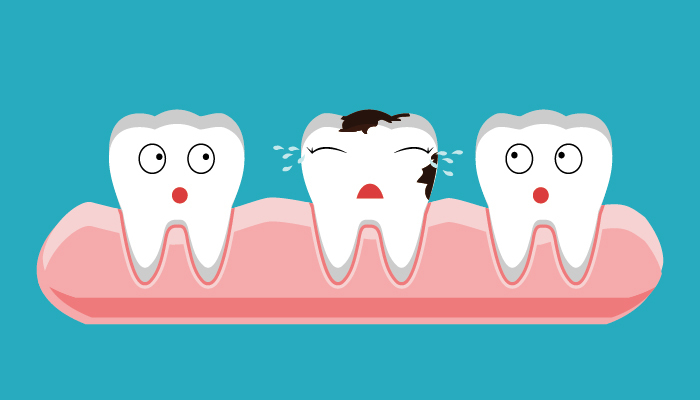Gum Disease and Your Body: A Quick and Easy Guide to Understanding Periodontal Disease
10 Jan 2017
We’ve all heard about gum disease, but how well do you really understand it? Besides being the number one cause of tooth loss, it has been linked to a host of health problems. Here is a simple guide to understanding the role your gums play in your health!
What is Periodontal Disease?
Periodontal or Gum disease is basically a bacterial infection that affects the tissues that support your teeth. That’s it. Germs attack your gums, ligaments, and bones around your teeth and cause infection and, if not treated, tooth loss. It also affects other tissues of your body, making it very important to catch and treat early.
Some Quick Facts about Gum Disease
- Leading cause of tooth loss
- Affects 50% of US population
- Treatable but not reversible
- Chronic and progressive – it gets worse over time without treatment
- Affects the health of the whole body
Are Gingivitis and Gum disease the same thing?
Gingivitis is another word to describe inflammation of the gums, which is an early stage of gum disease. At this phase, it is reversible. Gum disease is a progressive process. That means it worsens over time. It starts with gingivitis, and if it is left untreated it can progress to periodontitis.
What Are the Types of Gum Disease?
We will focus on the more common types. Gum disease happens as a process, beginning with gingivitis and progressing to periodontitis. That’s why catching it and treating it early is so important. While later stages of gum disease are treatable, they are not reversible.
- Gingivitis – inflammation of gums. Reversible with cleaning and regular hygiene.
- Periodontitis – gum disease. Destruction of supporting tissues of teeth. Ends in tooth loss
- Chronic – Most common type of gum disease.
- Aggressive – happens in people who are healthy, otherwise. Fast destruction of the tissues supporting the teeth. Commonly occurs in multiple family members.
How Does Gum Disease Work?
Let’s look at a healthy mouth. The teeth are attached to the bony sockets by a ligament. The gum covers the bone and attaches the teeth by little fibers of connective tissue, leaving a collar of tissue about 1-3mm tall around the neck of the tooth. The space between this tissue and your tooth is called a sulcus or a pocket. That’s the area your hygienist measures during your examination. This space is lined with tissue designed to keep bacteria out of the bloodstream and is easily cleaned with a toothbrush.
Gingivitis
When plaque bacteria invades that space between your tooth and gum, it causes inflammation. Have you ever noticed your gums bleeding when you brush or floss? Bleeding is caused by the bacterial attack on the lining of the pocket. It develops small ulcerations that bleed and allow bacteria into the bloodstream.
Progression
As the bacteria invade that space, the inflammation grows worse and the fibers that attach the gum to the tooth loosen and detach. Now, a small space of 1-3mm has gotten deeper and more bacteria show up to the party. The problem is, that once that pocket gets deep enough, you can no longer clean it with a toothbrush. Calculus, a hard deposit left by plaque bacteria, forms and serves as a kind of coral reef for bacteria. Gross!
Periodontitis
It gets worse! Now, you’ve got bleeding, inflamed tissues, calculus, and pockets that can’t be cleaned by a toothbrush or floss. The bacteria are inviting their friends. As the pockets get deeper, different kinds of bacteria start to show up–and they aren’t as friendly as the earlier bugs. These new deep pocket dwellers are destructive and they can wreak havoc on the tissues of your mouth and your body, once they get into the blood stream.
As the bacteria worsen, the lining of the pocket degrades. The fibers that attach the gums to the tooth loosen and allow for more bacteria to invade. The bone around the tooth is lost. Eventually, the tooth doesn’t have enough bone to support it and it becomes loose and falls out. The worst part is that all of this can happen with few if any symptoms! Sometimes, the first sign of gum disease is a loose tooth!

Gum Disease and Your Health
Gum disease isn’t only devastating to your mouth, it can seriously affect your overall health! Because the bacteria are able to enter your bloodstream through the ulcerated lining of the infected pockets, they are able to cruise your entire body looking for places to colonize. Not only that, the inflammation caused by gum disease is thought to contribute to other diseases of the body!
Diabetes
Gum disease has long been the bed partner of Diabetes. They love each other and each encourages the other to be worse. Take care of your gums and your body is better able to manage your diabetes and vice versa!
Heart Disease
While no one knows what the exact link is, research indicates that gum disease increases your risk of heart disease! It is believed the inflammation caused by gum disease is responsible for the increased risk.
Problems with Pregnancy
Research indicates that gum disease may be linked to premature birth and low-birth weights.
How Do I Know if I Have Gum Disease?
Your dental hygienist looks for signs of gum disease at your cleaning appointments. Your gums will be measured to make sure that the pocket depths are in the healthy range and that there is no bleeding! Bleeding is not normal! It is an indication that the lining of your pocket is infected and allowing bacteria to enter your bloodstream.
If you are overdue for your dental visit, pay attention to your gums when you brush and floss. Look for signs of gingivitis and gum disease including
- Bleeding
- Red gums
- Swollen gums
- Receding gums
- Bad breath
- Bad taste
Report any signs to your dental team at your next visit. Remember, catching gum disease early prevents tooth loss!
What are the Risk Factors For Gum Disease?
Gum disease, like all disease, has risk factors. Someone with three or more risk factors isn’t 3 times more likely to have gum disease occur or worsen, they are 27 times more likely to have gum disease occur or worsen!! If you have 4 or more risk factors, your likelihood is increased 64X! Major risk factors for gum disease are:
- Poor oral hygiene
- Age
- Genetics
- Smoking
- Stress
- Medications that cause dry mouth
- Grinding
- Obesity
- Diabetes
- Osteoporosis
- Poor Nutrition
- Faulty Restorations
- Misaligned teeth
Remember, gum disease is a bacterial infection. Anything that increases the bacteria in your mouth, increases your risk!
How is Gum Disease Treated?
Treatment for gum disease is focused on eliminating bacteria. Makes sense, right? In the case of gingivitis, this is accomplished with a cleaning and a return to a good oral hygiene regimen. For more advanced gum disease, the treatments will vary.
The results of your exam will determine your exact treatment. When your hygienist is measuring your pockets, they are looking for measurements of over 3 millimeters. They are also counting how many areas are bleeding. Don’t forget, bleeding indicates the presence of infection in the lining of your pockets. Once they have examined all your teeth and gums, they will make a treatment plan.
Types of treatment for gum disease
- Deep Cleaning/Scaling with Root Planing
- Areas to be cleaned are numbed. Teeth and teeth roots are cleaned under the gum using an ultrasonic scaler or other devices. Calculus (hard deposits formed by residual plaque) removed, tooth surfaces smoothed
- Laser treatment
- After a deep cleaning to remove hard deposits and plaque, a laser is sometimes used to eliminate bacteria from deep pockets.
- Surgery
- After a deep cleaning, some areas may need a surgery to reduce the pocket depth to remove areas where bacteria can congregate.
- Bone Grafting
- After a deep cleaning, some areas may benefit from an addition of bone.
Your dentist is trying to decrease the bacteria in your mouth and one way is to identify places bacteria can collect, like at the edges of bulky restorations or between overlapped teeth! Your dentist is also trying to support your teeth and make pay attention to your bite. In this effort, your dentist may recommend
- Improved restorations to replace bulky or jagged fillings or crowns
- Orthodontics to correct misaligned teeth that make cleaning difficult
- Tooth splinting to stabilize teeth
- Bite adjustment to reduce the load on overburdened teeth
Talk to your dentist about ways to decrease your risk for gum disease!

How Can I Prevent Gum Disease?
Now that you know what causes gum disease and what gum disease can do to your teeth and your body, what can you do to prevent it? While some risk factors for gum disease, like your genetics, can’t be changed, here is a list of things you can do to keep gum disease at bay!
- Oral hygiene is your friend! Brush at least twice a day and floss at least once a day
- Keep regular cleaning appointments! Your dental team is trained to look for early signs of gum disease. Make sure you get the most of their training! Overdue? Make an appointment today!
- Keep up with your health! Your oral health and overall health are a two-way street!
Related Blog Articles